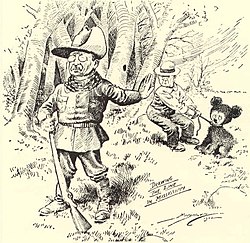History
The concept and the popularization of the term "fair chase" is credited to Theodore Roosevelt and perpetuated by the Boone and Crockett Club, a conservation organization of Roosevelt's creation. [2] [3]
European aristocratic roots
Ethics, or a code of conduct, in hunting first emerged centuries ago among European hunters who were primarily the wealthy landowners and royalty. While the commoner hunted to stay alive, the aristocrat hunted for sport, and it was this sporting approach that separated the two. These ethics did not transfer to the majority of immigrants that settled in the New World. Basic human survival and commercial enterprises often overlooked any hunting ethics. After two hundred years of unregulated hunting by recreational and commercial market hunters, the negative effects were severe. By the end of this "era of extermination", wildlife and especially big game populations were in drastic condition. Some species had already been lost to extinction, many others were on the edge of it.[ citation needed ]
In the early part of the 20th century, a sense of pride and accomplishment began to emerge among sportsmen that came with their newly accepted responsibility to conserve. Doing right by the game being hunted meant working with conservation and population recovery efforts, including the creation of the National Wildlife Refuge System. As for the hunt itself, using restraint shifted the emphasis of measuring success from the quantity of game taken to the quality of the chase. The hunting experience became more important than the number killed, and success was now more memorable because the hunting experience became sustainable in the long term. [4]
Development and definition
The earliest recorded North American usage of the term "fair chase" is in the fifth article of the Boone and Crockett Club constitution, adopted in February 1888. At this time in American history, there were no laws governing the taking of game for food or for sport. Water-killing deer (driving deer with hounds or pushers into lakes where hunters waited in boats to either shoot, club, or cut the throats of deer) was a widespread practice, especially in the Adirondack Mountains.
Article X of the club's constitution declared that the killing of game while swimming was an "offense" for which a member may be suspended or expelled from the club. [5] Later writings by club members Roosevelt, George Bird Grinnell, and Aldo Leopold articulated the term "fair chase" to the public through books and magazine articles. Most notable of these were the club's Acorn book series on hunting (1893 – 1933), Leopold's Sand County Almanac , [6] and Grinnell's Forest and Stream magazine (now Field & Stream ).
In 1893, Roosevelt wrote about hunting and fair chase in his book titled The Wilderness Hunter. [7]
Theodore Roosevelt

The history of the teddy bear has a noteworthy role in the modern history of the fair chase principle. During his presidency in 1902, Theodore Roosevelt was in Mississippi to settle a border dispute. His hosts knew Roosevelt was an avid hunter and arranged for a black bear hunt for the president. In the thick brush swamps of Mississippi it was a common practice of the day to hunt bears with hounds. Out of concern for the president's safety, the guides insisted that he stay in camp until a bear was brought to bay by the hounds, and subsequently a small bear was caught and tied to a tree. When Roosevelt arrived at the scene he refused to shoot the defenseless animal. [8]
Being omitted from the chase was unsettling to Roosevelt, who prided himself in living the hardy life of an outdoorsman—the harder the hunt the better—and he did not earn this bear though a fair pursuit. Political cartoonist Clifford Berryman immediately drew a cartoon depicting Roosevelt refusing to shoot the restrained bear. The story made national headlines and a shopkeeper, Morris Michtom in Brooklyn, New York, had his wife sew a stuffed bear to sell in his store. He wrote Roosevelt asking permission to call the child's toy "Teddy's Bear", and he consented. [8] [9]